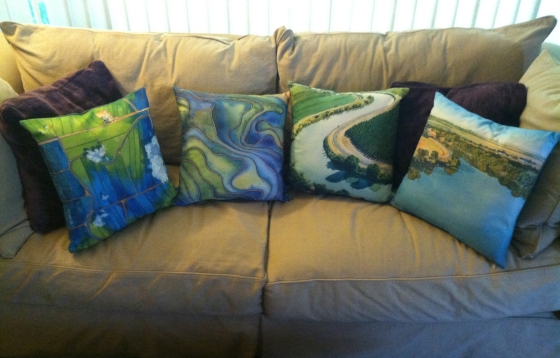My intentions after coming back from the New York watercolor show and after completing my big commission were to spend the summer creating many new paintings for the upcoming studio tour and make some blog posts. But…the universe had other plans for me. Just as Spring was ending I broke my wrist, which made my summer plans nearly impossible. I had to give priority to healing if I was ever to paint again. Now that I am on the road to recovery (but not quite up to painting) it’s a little easier to type, so I decided to share my inspiration for my paintings with you.
I have always loved the beautiful patchwork of the quilted farmlands and delta area of the Sacramento, California area. The meandering river across the agriculture and the velvety rice fields as seen from the air are amazing. I started painting this view to capture the feelings it evokes for me; a natural beauty that is fragile and ever changing depending on drought, season, time of day and human influences. I sought out small aircraft pilots to take me up so I could gather photos to paint from. I’ve had some wonderful experiences and met some interesting people. Taking flight is almost more fun than creating the actual painting! I have had some memorable flights in some historical planes including a 1940’s Piper Cub.

Piper Cub

Aeronca Champ
Recently I flew in an Aeronca Champ, which was a WWII training plane, owned by a family of pilots. It was originally purchased to commemorate a family member’s 60th birthday who had flown the same kind of plane in WWII. I heard some wonderful stories and family history as I flew with the pilot, and felt honored to be a passenger. I learned that during the war the tandem passenger seat behind the pilot was often removed so that an injured soldier could be slipped feet first into the tail and transported to safety. To think that this very plane may have saved a brave soldier was very humbling.

The tops of those radio towers were fascinating to see from that perspective!
We left out of a tiny private airport on the Sacramento delta late in the day so that I could get the long shadows that add some drama to my aerial paintings. My task was to get some good photos to use for a large commission I was starting. The challenge was that the ranch I needed to photograph was below five tall radio/TV towers. We needed to carefully fly around the towers and their many wire cables. I was also trying to include the river, small town of Walnut Grove and the iconic landmark, Mt. Diablo. I had to put my trust in the pilot that he would get us back safely and just enjoy the ride.

Walnut Grove, CA
We flew over the Sacramento River, the towns of Walnut Grove, Locke and Isleton, farmlands, pear orchards, marinas, bridges, dairy farms, wildlife preserves and breached levees. The vegetation was beautiful and varied. There were rows of trees and crops, manicured homes, gardens, fields, wild delta areas with patterned islands of cattails and marshlands. There were labyrinths of man made duck hunting ponds and sloughs choked with beautiful water hyacinth. There was a lone boat gliding past a string of tiny delta islands shaped like teardrops floating like gems on a necklace. All the while Mt. Diablo was watching us. It’s no wonder pilots love to fly over the delta – the view is breathtaking!

Oxbow Marina, Isleton
One of the many memorable sights was the Oxbow Marina in Isleton. It is a big loop on the river where there is a marina of boats and a resort.

Pear shaped pool
Nearby was a home with a pear shaped pool! The steps into the pool was the stem of the pear. It was obviously owned by a pear farmer.

Bridge to Nowhere
A surprising sight was the “Bridge to Nowhere” where long ago the levees were breeched. The land was allowed to be reclaimed by the river and is filling in with marshland making beautiful colored circles of vegetation in various sizes. The bridge once led to other farms, but now it’s a dead end to the water if one attempts to cross.

Sacramento Delta

Bridge on Steamboat Slough
I captured some great photos from that flight, which allowed me to complete my commission (shared in an upcoming post). My painting that was accepted into the American Watercolor Society Exhibition was from the same flight. If you look carefully in the lower right corner of that painting you can see the little airport I flew out of. The painting, “Diablo’s Delta” is currently touring the US for the next year in the AWS Traveling Exhibition. View my “Upcoming Shows” to see if it’s coming to a city near you.
Many thanks to my winged friends who share their passion with me and let me take flight with them so that I can share my passion with you!
Note – all photos are copyrighted by the artist and may not be used without permission.
























